

 |

|
ADMINISTRATIVE REPORT
Date: November 26, 2001
Author/Local: W. Chou/
604-873-7913
RTS No.: 01579
CC File No. 113
T&T: December 11, 2001
TO:
Standing Committee on Transportation and Traffic
FROM:
General Manager of Engineering Services in consultation with the Chief Constable & the Director of Legal Services
SUBJECT:
Small Motorized Vehicles II
RECOMMENDATION
A. THAT the Street & Traffic Bylaw be amended to permit the use of skates, skateboards, and push-scooters on minor streets, meaning streets without lane lines or directional dividing lines, as described in this report;
B. THAT permission for the use of skates, skateboards, and push-scooters, on minor streets, be for a one-year trial period;
C. THAT the Street and Traffic By-Law be amended to require the operator of skates, skateboard, or push-scooter on minor streets to be 16 years of age or older and to provide Police with identification upon request;
D. THAT the Street and Traffic By-Law be amended to require the operator of skates, skateboard, or push-scooter on minor streets to be equipped with safety gear during the one year trial period, as described in this report;
E. THAT the Street and Traffic By-Law be amended such that the operator of skates, skateboard, or push-scooter must travel in the direction of vehicular traffic and must travel as close as possible to the curb when operating on minor streets;
F. THAT the Street and Traffic By-Law be amended to prohibit the use of headphones while operating skates, skateboards, and push-scooters on minor streets;
G. THAT the Street and Traffic By-Law be amended to prohibit reckless operation of skates, skateboards, and push-scooters, meaning operating in such a manner as to obstruct traffic, or endanger the safety or property of themselves or others on minor streets;
H. THAT the Street and Traffic By-Law be amended to authorize Police to seize and detain skateboards, and push-scooters if used in contravention of the above recommendations, and to authorize fines as set out in the by-law;
I. THAT a one-time amount of $9,000 be added to the 2002 Engineering Operating Budget, subject to budget review, for educational materials (e.g., advertising, brochures) to notify the public of the changes in regulations regarding in-line skates, skateboards, push-scooters and electric motor assisted cycles; and
J. THAT Council authorize the Director of Legal Services to amend the Street and Traffic By-law generally in accordance with these recommendations.
COUNCIL POLICY
The Street and Traffic By-Law prohibits any person from propelling any vehicle (except light carriages or chairs for the conveyance of children or disabled), along, over, or across any sidewalk or boulevard except where it is specially constructed for vehicular traffic.
SUMMARY REPORT
The intent of this report is to review the status of skates, skateboards, push-scooters, electric cycles, and small electric motorized vehicles in the City of Vancouver.
At the June 22, 2000, meeting of Council's Standing Committee on City Services and Budgets, Council members directed staff to report back on where the use of in-line skates, skateboards, and push-scooters would be appropriate in the City. Staff have reviewed the use of these devices and now propose a one-year trial period to permit the use of skates, skateboards, and push-scooters on minor streets in the City.
The Insurance Corporation of British Columbia (ICBC) is currently proceeding with changes to the Motor Vehicle Act (MVA) to re-classify electric cycles such that they would be treated similar to bicycles. This means that electric cycles would not require registration, licensing, or insurance. These changes are expected to be completed early next year. Once complete, staff will work with ICBC to educate the public on the new regulations.
Electric small motorized vehicles, such as motorized push-scooters and skateboards, are currently prohibited in the City. ICBC has considered the use of these vehicles on streets; however, due to safety concerns they will not pursue this. As ICBC has found these vehicles to be unsafe, staff recommend no changes to the Street and Traffic By-Law to permit the use of these vehicles on City streets.
PURPOSE
At the June 22, 2000, meeting of Council's Standing Committee on City Services and Budgets, Council members directed staff to report back on where the use of electric small motorized vehicles, in-line skates, skateboards, scooters, etc., would be appropriate in the City of Vancouver, as in Recommendation G of Appendix A.
DISCUSSION
The use of skates, skateboards, and push-scooters, as shown in Appendix B, is growing from recreational activities to alternative modes of transportation. These vehicles are environmentally friendly, inexpensive, and convenient to operate. However, they are currently prohibited on public facilities that are not specifically designated for their use. Small electric motorized vehicles, such as electric cycles, are also emerging as alternatives to the car. ICBC is currently proceeding with amendments to the MVA to re-classify them such that they would be treated similar to bicycles. This would allow operators of electric cycles to travel on all bicycle facilities. However, municipalities would have the authority to restrict the use of electric cycles on specific facilities, such as the Seawall.
A. SKATES, SKATEBOARDS, & PUSH-SCOOTERS
Currently, the Street & Traffic By-law prohibits the use of skates, skateboards, and push-scooters on City streets, sidewalks, and pathways that are not designated for their use. At this time, Police members do not typically target the users of these vehicles. The By-law is generally enforced based on public complaints when they are operated in a reckless or irresponsible manner. Nevertheless, the in-line skating and skateboarding communities in Vancouver would like to see changes in the By-law to permit the use of in-line skates and skateboards on City streets. Therefore, staff have considered the options of leaving the Street & Traffic By-law as status quo, allowing police to enforce as necessary or amending the By-law to legitimize the use of these vehicles on local streets in the City.
Staff have reviewed the use of skates, skateboards, and push-scooters on City streets, sidewalks, and designated on-street bikeways and have considered a study conducted by the Transportation Association of Canada (TAC) which evaluates the use of in-line skates on public facilities in other jurisdictions. From this study conducted by TAC,it was found that in-line skating is more than a recreational fad and is continuing to grow in popularity as a viable mode of transportation. TAC also suggests that under specific conditions, in-line skaters can operate in harmony with pedestrians, cyclists, and vehicular traffic. A summary of the TAC In-Line Skating Review can be found in Appendix C.
Since the recommendations from the TAC report only pertain to in-line skating, staff have consulted with members of the Bicycle Advisory Committee (BAC), Stanley Park Skate Patrol, Vancouver Skate Park Coalition, Police, and Parks Board regarding the use of skates, skateboards, and push-scooters on City streets, sidewalks, and designated on-street bikeways.
In-Line Skates, Skateboards, Push-Scooters on City Streets
Based on discussions with these groups, it was concluded that skating, and skateboarding should be considered on City streets. However, safety concerns were raised regarding their use on streets as the skill level and techniques of skaters, skateboarders, and push-scooters vary so dramatically. For example, there are at least 6 methods of braking on in-line skates, and depending on the operator's skill level and method of braking, the stopping distance can vary significantly. Allowing in-line skaters, skateboarders, and push-scooters of all skill levels on the street, especially those who are inexperienced, may result in safety hazards. Furthermore, the study conducted by TAC found that the essential task of braking on in-line skates is the most difficult technique for beginners to master and it is the single operating characteristic that evokes the most concern amongst transportation professionals when it comes to considering in-line skates for use on streets.
By granting the operators of these devices the right to be on City streets, Police would not be given the authority to ticket inexperienced skaters. However, regulations such as age limit, requirement for identification, and safety equipment could be in place to assist Police with enforcing the use of in-line skates, skateboards, and push-scooters on City streets.
Based on these concerns, staff propose a one-year trial period to permit the use of skates, skateboards, and push-scooters on minor streets in the City. During the trial period, staff would continue to work with the BAC, Stanley Park Skate Patrol, Vancouver Skate Park Coalition, Police and Parks Board to monitor the use and safety of these vehicles in the City. It is also proposed that operators of these vehicles be required to wear safety equipment to help address the safety concerns.
In-Line Skates, Skateboards, and Push-Scooters on Sidewalks
It was considered by the majority of the groups that the use of these devices is not appropriate on sidewalks. Staff have received concerns from the public regarding clutter and crowded sidewalks especially in busy retail districts. Allowing skaters, skateboarders, and push-scooters on sidewalks may also compromise pedestrian safety, particularly pedestrians with limited mobility.
In-Line Skates, Skateboards, and Push-Scooters on Designated On-Street Bikeways
One option would be to limit the use of these devices to designated on-street bike routes. However, members of the BAC felt that in-line skaters, skateboarders, and push-scooters are generally slower than cyclists and that it would be difficult for cyclists to pass these vehicles on designated on-street bikeways. Members of the Stanley Park Skate Patrol, who also represent the in-line skating community in Vancouver, suggest that the road width required for in-line skating varies depending on the operator and that in-line skaters can adjust their stride to accommodate passing cyclists and narrow their stride in tighter spaces.
After reviewing the TAC, In-Line Skating Review and consulting with the BAC, Stanley Park Skate Patrol, Vancouver Skate Park Coalition, Police, and Parks Board, staff have considered the alternatives of leaving the Street & Traffic By-law as status quo or amending the By-law to permit the use skates, skateboards, and push-scooters in the City. Based on this review staff have found benefits and disadvantages with both options which are outlined below:
OPTION 1: Existing Street & Traffic By-law Remain Status Quo
Advantages - skaters, skateboarders, and push-scooters would not be given the right to be on City streets which would mitigate the concern of inexperienced skaters sharing the road with vehicular traffic.
- Existing By-laws make it easier for Police to enforce unsafe and reckless operation of these vehicles since they are prohibited.
Disadvantage - The City would not be recognizing these environmentally friendly modes of transportation.
OPTION 2: Amend the Street & Traffic By-law to permit skates, skateboards, and push-scooters on:
a) on bike routes only;
b) on all minor streets;
c) on all streets; and
d) on all streets and sidewalks.
Advantage - The use of skates, skateboards, and push-scooters would become a legal alternative mode of transportation.
Disadvantages - All skaters, skateboarders, and push-scooters, even those with limited skill and experience, would have the right to be on City Streets, sharing the road with traffic.
- By amending the By-law to permit the use of skates, skateboards, and push-scooters, it would be more difficult to prosecute operators using these devices in an unsafe or reckless manner.Staff propose a trial period of one year of option 2(b) to permit the use of skates, skateboards, and push-scooters on minor streets. This would give staff the opportunity to evaluate the use of these devices in the City. Once the trial period is complete, staff would report back to Council on the findings.
It is recommended that the use of skates, skateboards, and push-scooters be limited to minor streets, meaning streets without lane lines or directional dividing lines, where traffic volumes and speeds are generally lower. This will help to address the safety concerns regarding operators with limited skill, and help to minimize any traffic impacts. In addition, regulations, such as age limit, identification, and requirement for safety equipment are recommended to assist police in regulating the use of these devices. The following is a summary of staff recommendations:
1) That use of skates, skateboards, and push-scooters be permitted on minor streets, meaning streets without lane lines or directional dividing lines;
2) That permission for the use of skates, skateboards, and push-scooters, on minor streets, be for a one-year trial period;
3) That the operator of skates, skateboard, or push-scooter on a minor street be 16 years of age or older and must provide Police with identification upon request;
4) That the operator of skates, or skateboard must be equipped with a helmet; wrist guards; elbow pads; knee pads; front and rear reflective equipment; and brakes when operating on minor streets in the City;
5) That the operator of a push-scooter must be equipped with a helmet; elbow pads; knee pads; front and rear reflective equipment; and brakes when operating on minor streets in the City;
6) That the operator of skates, skateboard, or push-scooter must travel in the direction of vehicular traffic and must travel as close as possible to the curb when operating on minor streets;
7) That the use of headphones while operating skates, skateboard, or push-scooter on minor streets be prohibited;
8) That the reckless operation of skates, skateboards, and push-scooters, meaning operating these devices in such a manner as to obstruct traffic, or endanger the safety or property of themselves or others, be prohibited; and
9) That Police be authorized to seize and detain skateboards, and push-scooters if used in contravention of the above recommendations, and to authorize fines as set out in the by-law.B. ELECTRIC CYCLES
ICBC is currently proceeding with amendments to the Motor Vehicle Act (MVA) to re-classify electric cycles such that they would be treated similar to bicycles. An electric cycle is a bicycle modified with an electric motor for propulsion. The motor is intended to be used as a secondary source of power to assist the operator when necessary, thus expanding the range of people who can use cycling as a mode of transportation. Pictures are displayed in Appendix D.
The following is a summary of the requirements proposed for the electric cycle regulations (details of the ICBC - Notice of Proposed Rule Making can be found in Appendix E):
Propulsion system: electric motor only
Max. power output: 500 Watts
Max. speed: 32 km/h on level ground
Max. weight: 50 kgPresently, electric cycles must be registered, licensed, and insured as Limited-Speed Motorcycles and operators must have a drivers license. Therefore, they are only permitted on roadways and are prohibited on off-road pathways. ICBC is now proceeding to change this regulation to remove electric cycles from the motor vehicle category. This means that they will not require registration, licensing, or insurance, and the operator will not need to have a drivers licence.
With these changes in regulation, electric cycles would be permitted on all bicycle facilities. However, on July 31, 2001, Council passed an amendment to the Street & Traffic By-law to prohibit any motorized vehicle including electric cycles on any path adjacent to the seawall, except for motorized wheelchairs. Therefore, in Vancouver, electric cycles are permitted on all bicycle facilities except any pathway adjacent to the Seawall.
ICBC expects to have the amendments to the MVA finalized early next year and once complete, ICBC plans to initiate a program to educated the public regarding the use of electric cycles on roadways. Staff will work with ICBC to assist with this program to educate the public on the new regulations.
C. ELECTRIC MOTORIZED VEHICLES
Council, at its meeting on June 22, 2000, heard a delegation supporting the use of electric motorized push-scooters in the City. A brief demonstration of this device was provided and at that time Council directed staff to report back on where the use of electric small motorized vehicles would be appropriate in the City. Examples of small motorized vehicles are shown in Appendix F.
Presently, regulations in the MVA prohibit the use electric small motorized vehicles, such as motorized push-scooters and skateboards, on any roadway since they do not comply with the safety standards. Also, regulations in the City's Street & Traffic By-law prohibit the use of any motorized vehicle on sidewalks and boulevards. ICBC has considered the use of these vehicles on the roadway, however due to safety reasons, such as small wheel diameters, lack of safety equipment, and inadequate braking and steering systems, ICBC has not pursued this further. As ICBC has found these vehicles to be unsafe, staff do not recommend any changes to the Street & Traffic By-Law to allow small motorized vehicles on City streets. A report on the safety of motorized scooters by the U.S. Consumer Product Safety Commission is included in Appendix G.
FINANCIAL IMPLICATIONS
It is proposed a one-time amount of $9,000 to be added to the 2002 Operating Budget, that would be used to educate the public on these changes. Besides advertisements in local papers (at least 2 - 3 placements over the course of spring/summer) and posters, communications would also involve creating a brochure or rackcard that would clearly outline the rules for allowing in-line skates, skateboards, push-scooters and electric motor assisted cycles on minor streets. The rack cards would be widely distributed to civic facilities, as well as retail outlets where such equipment is sold, high schools and posts secondary institutions, and through community groups that serve the target audience. A web page on the City's site would also supplement information provided in hard copy.
CONCLUSIONS
The use of skates, skateboards, and push-scooters is growing from recreational activities to transportation alternatives. The study conducted by TAC shows that in-line skating will continue to grow in popularity and is more than just a fad. Currently, regulations in the City's Street & Traffic By-law prohibit the use of skates, skateboards, and push-scooters on public facilities that are not designated for their use. However, Police do not typically target operators of these vehicles unless they are being used in a reckless or irresponsible manner. Nevertheless, there is a need expressed by the in-line skating and skateboarding communities in Vancouver to legalize the use of in-line skates, and skateboards on City streets.
As a result, in consultation with the BAC, Stanley Park Skate Patrol, Vancouver Skate Park Coalition, Police and Parks Board, staff have considered a number of options regarding the use of skates, skateboards, and push-scooters. Staff propose a one-year trial period to allow the use of skates, skateboards, and push-scooters on minor streets in the City. This would provide the opportunity to study the use of skates, skateboards, and push-scooters. Once the trial period is complete, staff would report back to Council with its findings. In addition, regulations, such as age limit, identification, and requirement for safety equipment are recommended to assist police in regulating the use of these devices.
ICBC is currently proceeding with changes to the MVA to re-classify electric cycles such that they would be treated similar to ordinary bicycles. This means that electric cycles will not require registration, licensing, or insurance. Therefore, operators of these vehicles would be permitted on all streets and bicycles paths. However, Council has passed an amendment to the Street and Traffic By-law to prohibit the use of any motorized vehicle, with the exception of motorized wheelchairs, on the seawall. The amendments to the MVA are expected to be completed early next year. At that time, staff will work with ICBC to educate the public on the use of electric cycles in the City of Vancouver.
Regulations in the MVA and the City's Street and Traffic By-law currently prohibit the use of small electric-motorized vehicles, such as electric push-scooters and skateboards, on streets, sidewalks, and boulevards. ICBC has considered the use of these vehicles on the roadway; however, due to safety reasons they will not pursue this further. As ICBC has found these vehicles to be unsafe, staff propose that the existing Street & Traffic By-Laws regarding motorized vehicles remain as status quo.
* * * * *
APPENDIX A
Small Motorized Vehicles RTS#01510 CC File: 113
A. THAT the Street and Traffic Bylaw be amended to prohibit the use of any internal combustion motorized push-scooters, internal combustion motorized skateboards or other similar small internal combustion motorized vehicles on any street or other public place;
B. THAT the Street and Traffic By-Law be amended to authorize Police to seize and detain such motorized push-scooters, motorized skateboards or other small motorized vehicles if used on streets in contravention of the prohibition referred to in a, and to authorize appropriate fines as set out in the By-law;
C. THAT Staff notify the public of the prohibition of any such small motorized vehicle on public property through advertisements, at a cost of $5,000 from the Contingency Reserve Account;
D. THAT a recommendation be sent to the Union of British Columbia Municipalities (UBCM) to encourage the Province to develop standards and testing for safety, noise, and emissions from mopeds and other small internal combustion engines.
- CARRIED UNANIMOUSLY
The following motion by Councillor Price was put.
E. THAT the Street and Traffic By-Law be amended to prohibit the use of all motorized vehicles, assisted or otherwise, on seawalls, with the exception of motorized wheelchairs.
- carried unanimously
The following amendment by Councillor Bass was put and lost.
THAT the Street and Traffic By-Law be amended to prohibit the use of all motorized vehicles, assisted or otherwise, on seawalls, with the exception of motorized wheelchairs and electric scooters.
- LOST
(Councillors Clarke, Kennedy, Daniel Lee, Don Lee, Louis,
McCormick, Price, Puil, Sullivan and the Mayor opposed)
Clause No. 3 (cont'd)
The amendment having lost, Councillor Price's motion was put and carried. The Committee, therefore,
RECOMMENDED
E. THAT the Street and Traffic By-Law be amended to prohibit the use of all motorized vehicles, assisted or otherwise, on seawalls, with the exception of motorized wheelchairs.
- CARRIED UNANIMOUSLY
The following motion by Councillor Price was put and carried. The Committee, therefore,
RECOMMENDED
F. THAT all motorized vehicles, assisted or otherwise, be licensed, and that ICBC be requested to proceed with this under Class 5 licensing;
G. THAT Staff report back on where the use of electric small motorized vehicles, in line skates, skate boards, scooters, etc., would be appropriate in the City of Vancouver.
- CARRIED UNANIMOUSLY
APPENDIX B
In-line Skate
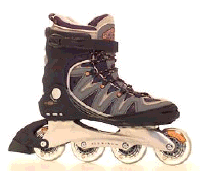
Skateboard
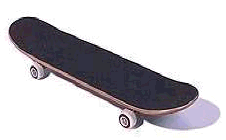
Push-scooter
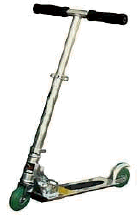
APPENDIX C
Transportation Association of Canada - In-line Skating Review: Phase 2
NOTE FROM CLERK - Appendix C is not available in electronic form - on file in the Office of the City Clerk.
APPENDIX D
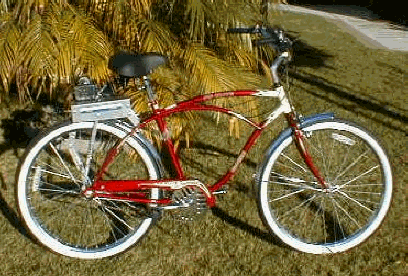
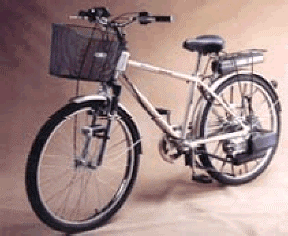
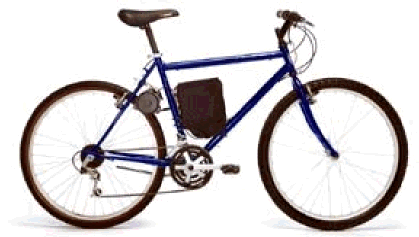 Motor-Assisted Bicycles
Motor-Assisted Bicycles
APPENDIX E
ICBC Notice of Proposed Rulemaking
NOTE FROM CLERK - Appendix E is not available in electronic form - on file in the Office of the City Clerk.
APPENDIX F
Motorized Push-Scooters
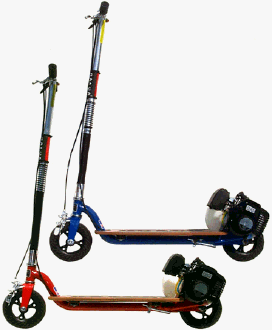
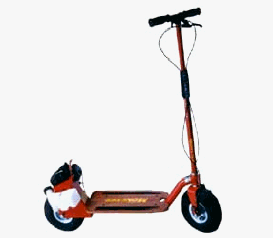
Motorized Skateboards
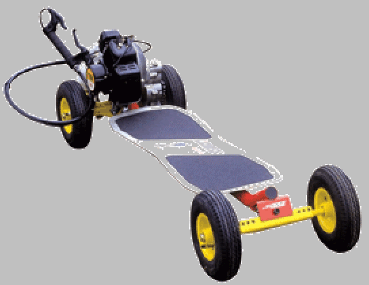
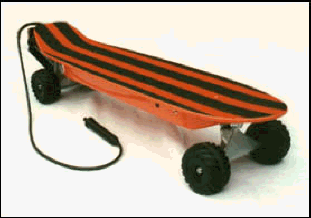
APPENDIX G
NEWS from CPSC
U.S. Consumer Product Safety Commission
Office of Information and Public Affairs Washington, DC 20207
--------------------------------------------------------------------------------
FOR IMMEDIATE RELEASE
August 22, 2001 Contact: Mark Ross
Release # 01-222 (301) 504-0580 Ext. 1188
Motorized Scooter Use Increases and Injuries Climb
WASHINGTON, D.C. - The U.S. Consumer Product Safety Commission (CPSC) today reported 2,250 emergency room-treated injuries associated with motorized scooters in the first 7 months of this year. If injuries continue at this rate, the total estimate for 2001 is expected to show a marked increase over 2000. The first full year in which CPSC collected data on these injuries was 1999. In 2000, there were an estimated 4,390 hospital emergency room treated injuries associated with motorized scooters. This represents more than a 200-percent increase over the 1999 estimate of 1,330 injuries.
CPSC is aware of at least three deaths associated with motorized scooters. Two of the deaths involved children, including a 6-year-old boy in California who died after falling off a motorized scooter and an 11-year-old boy in Pennsylvania who died when the motorized scooter he was riding crashed into a truck. Also, a 46-year-old man died in California after being struck by an automobile. All of the victims suffered head injuries; none was wearing a helmet.
CPSC recommends that riders wear the same safety gear as we recommend for non-powered scooters - a helmet, and knee and elbow pads. Sturdy shoes also are important. CPSC Chairman Ann Brown said, "Common sense requires that riders of all ages understand the importance of protective gear and observing local safety rules. Have fun outside but don't end up in the emergency room."
In 2000, an estimated 39 percent of the injuries occurred to children under 15 years of age. Most injuries occurred to the arms, legs, faces, and heads. The most common injuries were fractures.
Motorized scooters are increasing in popularity. They are two-wheel scooters, similar to the unpowered scooters, but equipped with either a small 2-cycle gasoline engine or an electric motor and a battery. Some manufacturers are retrofitting stocks of non-powered scooters with electric motors. In addition, kits are available to retrofit non-powered scooters. The gasoline-powered scooters usually cost between $400 and $1,300. The electric scooters range from under $200 to about $1,000.
Protective gear, including helmet and knee and elbow pads, is available for less than $35.
CPSC recommends the following safety guidelines:
· Wear a bicycle helmet that meets CPSC's standard, along with knee and elbow pads.
· Wear sturdy shoes.
· Owners of motorized scooters should check with local authorities for riding guidelines and restrictions.
· Do not ride at night.
· Children under 12 should not ride motorized scooters.
The U.S. Consumer Product Safety Commission protects the public from unreasonable risks of injury or death from 15,000 types of consumer products under the agency's jurisdiction. To report a dangerous product or a product-related injury, call CPSC's hotline at (800) 638-2772 or CPSC's teletypewriter at (800) 638-8270, or visit CPSC's web site at http://www.cpsc.gov/talk.html. For information on CPSC's fax-on-demand service, call the above numbers or visit the web site at http://www.cpsc.gov/cpscpub/pubs/103.html. To order a press release through fax-on-demand, call (301) 504-0051 from the handset of your fax machine and enter the release number. Consumers can obtain this release and recall information at CPSC's web site at http://www.cpsc.gov.
http://www.cpsc.gov/cpscpub/prerel/prhtml01/01222.html 9/5/2001
![[City Homepage]](/graphics/footnava.gif)
|
![[Get In Touch]](/graphics/footnavb.gif)
|

|

|

|
(c) 1998 City of Vancouver